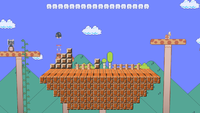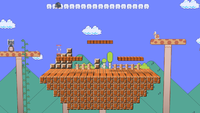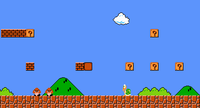Mushroom Kingdom (SSB)
| Super Mario Bros. Mushroom Kingdom | |
|---|---|
{{{content1}}}
{{{content2}}}  Mushroom Kingdom as it has appeared in the Smash series. | |
| Universe | Mario |
| Appears in | SSB Ultimate |
| Availability | Unlockable (SSB) Starter (Ultimate) |
| Unlock criteria | Clear 1-Player mode with the eight starter characters, and play every other stage in Vs. Mode. Play 50 games in Vs. Mode. |
| Crate type | Normal |
| Maximum players | 4 (SSB) 8 (Ultimate) |
| Article on Super Mario Wiki | Mushroom Kingdom (Super Smash Bros.) |
Mushroom Kingdom (いにしえの王国, Ancient Kingdom) is the only unlockable VS. Mode stage in Super Smash Bros. While it does not return in Super Smash Bros. Melee, a similar stage also called Mushroom Kingdom appears. The stage later returns in Super Smash Bros. Ultimate as a familiar stage.
This stage is the only one which is never seen in 1-Player mode: even if it is unlocked, Mario and Luigi will still be fought on Peach's Castle.
Stage overview
In the middle of this stage is a pit. To the right of it, there are two soft floating platforms, and a pipe to the right of them. To the left of the hole, there is a single floating soft platform, and a solid brick platform left of that which extends to the edge of the stage. In the background, a grey castle can be seen, along with some mushroom platforms.
This stage is unique among the ones in Smash 64 in that it features walk-off blast lines: this is even further referenced by a "danger" sign that appears beyond the blast lines themselves.
There are three pipes which characters can warp in between. When standing on a pipe, if the player presses down on the controller, their character will transfer through to another pipe. In Ultimate, down must be held for a moment before the pipe will be entered, and after a character travels through one, they cannot use the pipes again for another 13 seconds to prevent abuse of the warps. One of these pipes is on the ground to the right of the stage, and another is on top of the brick platform to the left. There is a third pipe embedded in the left wall of the chasm, in such a way that only its mouth can be seen; in 64 this pipe is exit-only but enterable in Ultimate by holding left while next to it, although there is a chance the pipe will reject the character and immediately spit them back out. Characters are randomly sent to either pipe, although if one pipe is blocked, the character will always come out of the alternate pipe. Additionally, two Piranha Plants occasionally come out of the pipes and inflict low damage (5%), but can be knocked away with a powerful attack (or by hitting them enough times). The Piranha Plants knock any characters who hit them straight upward with relatively high base knockback albeit extremely low knockback scaling, usually not KOing until very high percentages. They can be used during combos or to setup moves. Using the pipes is not typically a reliable strategy, as the player may exit into the abyss, which could lead to the player falling down the bottom blast line and self-destructing, or at minimum being left open to attack.
In the middle of this stage is a fissure, which is the only place in the stage where players can be KO'd by falling down. Above the crevasse is a scale with two soft platforms. It is possible to stand on the two platforms, but the character's weight will unbalance them. If unbalanced too far, the system will break and fall into the crevasse, and then regenerate a few seconds afterwards. This gap is the cause of many AI flaws.
Occasionally, a small, rectangular POW Block will appear in one of several locations in the air. Hitting it with an attack will cause the screen to vibrate, with every character touching the ground or a platform being dealt 20% damage and great knockback.
Technical information
In Smash 64, landing on one of the scale platforms will impart a speed of -8×(2.4-w)+0.9, where w is the fighter's weight. Every frame afterwards will accelerate the platform by -(2.4-w)+0.9. When both platforms have a fighter on them, the left platform (the right platform bases its movements on the left) will change its speed every frame using (s+(w1-w2))×0.93, where s is the platform's current speed and w1 and w2 are the weights on each platform, up to a speed of around (w1-w2)×1.32857. Due to how speed is calculated, a weight above around 1.5174 will not cause the platforms to break off in a single jump (jumping after it has moved will impart the same speed as the first but at a lower height, thus allowing it to break), a weight of 2.4 will do nothing, and a weight above 2.4 will cause the platform to rise; these scenarios are not possible without hacking as the highest weight value is 1.3 with Jigglypuff.
The left platform starts at a height of 363 and the right platform starts at 362. Once the difference between one of the platform's starting height and current height exceeds 1100, the platform will become detached from the rope. Once detached, the platforms' speed is reset to 0 and increases by 3 every frame until it reaches 70. The platforms will continue to fall until both pass a height of -5350, at which point they will reappear 3 seconds later.
In Ultimate the platform's movements are simpler; while jumping onto a platform will impart an initial speed like in Smash 64, this speed quickly dissipates and is overtaken by the primary mechanic. When landing on one platform, that platform will fall at a constant rate of 0.008675w-0.35 units per frame, where w is the fighter's weight with a minimum of 40. When both platforms have a fighter on them, the one with the heaviest fighter will fall at a rate of 0.0133×(w1-w2) units per frame (the other platform will rise at the same rate), where w1 and w2 are the weights on each platform. Both platforms start at a height of 13 units and detach from the rope when the difference in starting height and the current height is more than 40.
Ω form and Battlefield form
In Super Smash Bros. Ultimate, the Ω form and Battlefield form are suspended in the air with no platforms extending below the blast line and no walk-offs. The POW Block, scales, and Warp Pipes are also absent. The main platform is an arrangement of ground blocks that match the size and shape of Final Destination and Battlefield, respectively. In order for fighters to not get stuck in the corners when recovering, and to make this form match their respective forms, there are invisible slopes along both sides. The three soft platforms of the Battlefield form are based off the soft platforms of the regular form.
Hazards Off
With stage hazards turned off in Ultimate, POW blocks and Piranha Plants never appear, it’s impossible to use through the warp pipes, and the balancing platforms are absent.
Origin
This stage is based on the overworld levels of Super Mario Bros., in which Mario can enter Warp Pipes to underground levels or bonus rooms; when underground, the player has to go into another Warp Pipe to return to the overworld. Some Warp Pipes have Piranha Plants that emerge from them as a hazard. There are also certain levels that have scales that have a platform that goes down when Mario is standing on it, while the other platform connected to it goes up. If Mario stands on the platform for too long, the scale breaks and both platforms fall. This stage retains the aforementioned elements; however, the Piranha Plants are red, as in Super Mario Bros.: The Lost Levels from World 4 onward.
In the arcade game Mario Bros., the goal is to hit the enemies from under a platform to flip them over, and then get to the top of the platform to kick them off. If the player feels overwhelmed by how many enemies are on the screen at once, the player can go to a POW Block to knock all the enemies on their back. In this stage, if a fighter hits the POW Block that occasionally appears, it launches their opponents upward.
There are also many elements in the background that are from Super Mario Bros., such as Koopa Troopas, Mushroom Platforms, a Beanstalk, a Goal Pole, etc.
Tournament legality
This stage is universally banned in standard tournaments due to hazards such as the POW blocks and randomized Piranha Plants disrupting gameplay, the pipes allowing heavy side camping, and the walk-off blast lines allowing even further side camping and allowing characters who can chaingrab past the blast line (such as Pikachu using its forward throw) to KO at very low percentages. Alongside Sector Z, it has never been considered a legal stage.
Gallery
Super Smash Bros.
Super Smash Bros. Ultimate
Piranha Plant firing poison at Toon Link on the stage.
Names in other languages
Trivia
- Every subsequent installment in the Super Smash Bros. series has had a Mushroom Kingdom-based stage (a stage related to "Mushroom Kingdom", or any name based on that phrase). Melee had Mushroom Kingdom and the Super Mario Bros. 2-based Mushroom Kingdom II, Brawl had Mushroomy Kingdom, Super Smash Bros. 4 had Mushroom Kingdom U in the Wii U version and Mushroomy Kingdom as a returning stage in the 3DS version, and Ultimate had all of the Mushroom Kingdom stages, except for Melee's Mushroom Kingdom.
- In Ultimate, this stage is referred within game files with the codename "mario_past64". The phrase "past" can be an alternative to "ancient", the stage's Japanese name, and is shared with Mushroom Kingdom II and Mushroomy Kingdom.
- The German name of this stage in Super Smash Bros. translates to "Donut Plains", an unrelated location from Super Mario World. In Ultimate, this has been corrected to reference Mushroom Kingdom.
- During the final 30 seconds of the match and Sudden Death, the "Hurry up!" jingle will play and the music will speed up (as it does in Super Mario Bros. when the timer reaches 100 units). In Ultimate only, this also occurs when one of the fighters is on their last stock.
- This is one of the five stages in the Smash Bros. series to change music when the timer reaches 30 seconds and during Sudden Death, the others are Mushroom Kingdom (SSBM), Mushroom Kingdom II, Suzaku Castle (if the music played is any type of one of the sixteen playable characters in Street Fighter II and Super Street Fighter II), and Moray Towers.
- In Ultimate, if the Ice Climbers use the pipes, one may not come out of the same pipe as the other. In addition, Pikmin and Luma cannot use the pipes.
- Also in Ultimate, this is one of the few stages where every Assist Trophy can appear.
- In Smash 64, all characters have unique animations for entering and exiting the pipes. However, this isn't present in Ultimate.
- This stage and Saffron City share the longest gap between appearances in the Super Smash Bros. series, with nearly nineteen years between Smash 64 and Ultimate.
| Stages in Super Smash Bros. | |
|---|---|
| Starter stages | Congo Jungle · Dream Land · Hyrule Castle · Peach's Castle · Planet Zebes · Saffron City · Sector Z · Yoshi's Island |
| Unlockable stage | Mushroom Kingdom |




